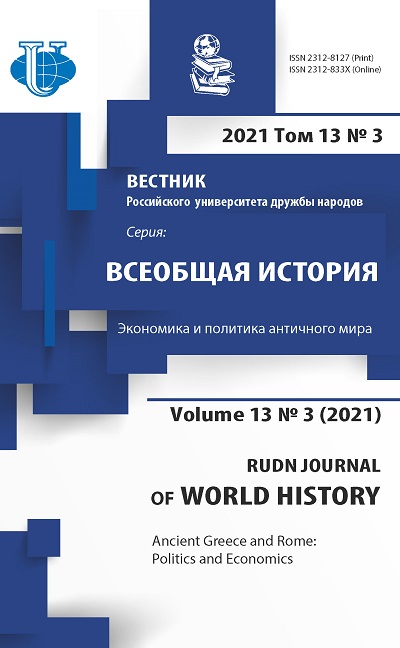Dynastic marriages of client kings during the reign of Augustus
- Authors: Nikishin V.O.1
-
Affiliations:
- Moscow State University named after M.V. Lomonosov
- Issue: Vol 13, No 3 (2021): Ancient Greece and Rome: Politics and Economics
- Pages: 310-318
- Section: INTERNAL AND FOREIGN POLICY OF ANCIENT ROME
- URL: https://journals.rudn.ru/world-history/article/view/27325
- DOI: https://doi.org/10.22363/2312-8127-2021-13-3-310-318
Cite item
Full Text
Abstract
The article examines the practice of entering into dynastic marriages as part of the policy that was held in relation to vassal kings during the reign of the emperor Augustus (30 BC - AD 14). The author introduces the term “Augustus’ project”, bearing in mind the package of measures, aimed at creating a system of vassal kingdoms on the outskirts of the Roman Empire. According to the author, dynastic marriages as an effective instrument of real policy should have cemented the building blocks of the system. In the main part of the article the author analyses ten well-known dynastic marriages, related to the reign of Augustus. As a result of the research undertaken, the author concludes that Augustus, of course, sought to control the behavior of the kings-collaborators. Sometimes things got out of hand, and then the emperor should have intervened to resolve the resulting “conflict of interests”. The author asks: what did Augustus demand of vassal rulers? The answer is: loyalty and efficiency in the administration of the territories entrusted to them, which meant not only the timely dispatch to Rome of established monetary sums (tributes, taxes and other payments), but also to protect the local population from external enemies, as well as political stability and the rule of law. If it was all there and there was no danger, real or potential, for the peace and stability of the empire, Augustus overlooked extravagant matrimonial combinations, polygamy, conflicts with children and other “excesses” in the family life of dependent kings. But when it came to questioning loyalty and efficiency, Augustus was unmerciful and merciless in punishing the guilty. Immediate successors to Augustus rejected the “Augustus’ project” and gradually eliminated most vassal kingdoms, turning them into provinces under the control of the governors.
About the authors
Vladimir Olegovich Nikishin
Moscow State University named after M.V. Lomonosov
Author for correspondence.
Email: cicero74@mail.ru
candidate of sciences (history), senior lecturer, department of ancient history, faculty of history
27, b. 4, Lomonosovsky prospect, Moscow, Russian Federation, 119234References
- Blavatskiy VD. О Reskuporide Pervom [About Rescuporides the First]. Sovetskaya arheologiya. 1976;(4):56–62. (In Russ.).
- Nikishin VO. Kak kultura preodolela negativnyi stereotip: portret mavretanskogo tsarya Juby II v kontekste rimskih etnicheskih predrassudkov [How the culture overcame a negative stereotype: the portrait of king Juba II of Mauretania in the context of Roman ethnic prejudices]. Еgipet i sopredelʼnyie strany. 2017;(2):43–59. (In Russ.).
- Nikishin VO. Rim i vassalʼnyie tsari: o nekotoryh aspektah vzaimootnosheniy [Rome and vassal kings: about some aspects of the relationship]. Antichnyi mir i arheologiya. 2019;(19):129–168. (In Russ.).
- Saprykin SYu. Zhenshchiny-pravitelʼnitsy Pontiyskogo i Bosporskogo tsarstv (Dinamiya, Pifodorida, Antoniya Trifena) [Women rulers of the Pontic and Bosporan kingdoms (Dynamis, Pythodoris, Antonia Tryphaena)] Zhenshchina v antichnom mire. By ed. Marinovich L.P., Saprykin S.Yu. Moscow, 1995:181–203. (In Russ.).
- Braund DC. Rome and the Friendly King: The Character of the Client Kingship. London: Croom Helm, 1984.
- Braund DC. Anth. Pal. 9. 235: Juba II, Cleopatra Selene and the Course of the Nile. Classical Quaterly. 1984;34(1):175–178.
- Harris WV. War and Imperialism in Republican Rome, 327–70 B.C. Oxford: Clarendon Press, 1979.
- Nawotka K. The Attitude towards Rome in the Political Propaganda of the Bosporan Monarchs. Latomus. 1989;48(2):326–338.
- Roller DW. The World of Juba II and Kleopatra Selene: Royal Scholarship on Rome’s African Frontier. London: Routledge, 2003.
- Roller DW. Scholarly Kings: The Writings of Juba II of Mauretania, Archelaos of Kappadokia, Herod the Great, and the Emperor Claudius. Chicago: Ares Publishers, 2004.
- Roller DW. Cleopatra’s Daughter and Other Royal Women of the Augustan Era. New York: Oxford University Press, 2018.
- Romer FE. A Case of Client-Kingship. American Journal of Philology. 1985;106:75–100.
- Shillam MW. Imperial Matchmaker: The Involvement of the Roman Emperor in the Arrangement of Marriages between Client Kings. PhD thesis. University of New England, 2016.
- Sullivan RD. The Dynasty of Emesa. Aufstieg und Niedergang der römischen Welt. T. II. Bd. 8. Berlin, 1977. P. 198–219.













